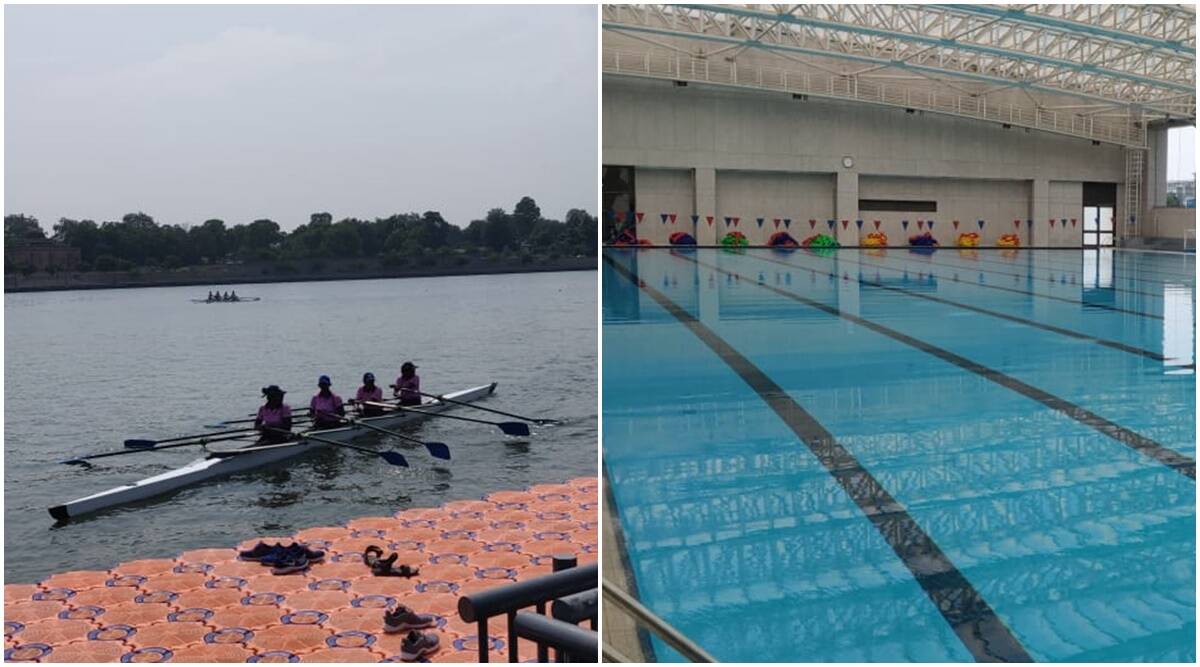Triathletes at the 36th National Games were to swim in the Sabarmati River to compete for over 750 metres in open waters, in addition to biking 20 kilometres and running 5km. But they will now swim within the confines of an Olympic-size pool — 50 metres in length — at the Indian Institute of Technology, Gandhinagar instead.
The reason: the green-coloured water of the Sabarmati river, described by organisers as ‘unhygienic and infectious’ that could result in swimmers getting infections.
Since July, when the Indian Olympic Association (IOA) announced Gujarat as the host of the National Games, Amdavad Municipal Corporation officials had conducted multiple tests to check the quality of the Sabarmati water.
“The results showed the quality of water wasn’t nice at all. And since the water is very polluted, it was suggested the event should not be held here,” Virendra Nanavati, the vice-president of the Gujarat State Olympic Association, told The Indian Express. “We argued that in rowing (the other sport that’s being held at the venue), they put boats in the water and people don’t come directly in contact with it. That’s not the case in swimming and we’d risk infecting people if they swam in the water.”
Nanavati added that as drainage water is released into the river, it made the venue unsuitable. “We hoped that it would get better once the monsoon began, assuming that the water will get washed and cleaned. But nothing really happened,” Nanavati, also a veteran swimming administrator, said.
Hence, at the last moment, the triathlon venue was moved to Gandhinagar.
The triathlon consists of three segments: 750m swim, 20km cycling and 5km road race.
According to triathlon competition manager Harish Prasad, the water quality test is carried out routinely and a final test is done roughly a fortnight before the start of the event. The water, he said, “need not be consumable but it should not harm the athlete”.
Ahmedabad’s riverfront had emerged as an ideal location to host the triathlon because it also has a perfect promenade to transition from one segment of the race to another and is in close proximity to roads that can be used for cycling and running.
Porbandar, which held a triathlon national championship back in 2007, emerged as an alternate. However, conducting the races there would have posed the organisers with the logistical problem of accommodating hundreds of people in a small city. It would also have meant expanding the Games to seven cities — from six — which would’ve been another hurdle.
Other locations were not considered, according to a Sports Authority of Gujarat official, because of the state government’s crocodile conservation project. Many rivers and lakes across Gujarat, the official said, are infested with the reptile, making it unsafe to conduct swimming races there. And even if there were crocodile-free venues, a good road for cycling wasn’t easily accessible from the water body.
It reached a point in early September where the sport was almost dropped from the Games programme.
A different challenge
While it’s not unheard of to hold triathlon swimming races in a swimming pool, it’s uncommon since all top races are held in open waters, including at the Olympic Games.
From October 9 to 11, a total of 32 men from 23 states and 30 women from 16 states will compete in the triathlon at the National Games. Two athletes will occupy one lane and jump into the pool in two waves to avoid congestion. Each will have to swim 15 laps of the pool.
Pratap Mohan, father and coach of one of India’s top triathletes Pragnya, said swimming in open waters is a lot tougher. “In open water, the swimmer has to find his or her own line to swim, making it that much more challenging,” Mohan said. “And in a pool, you also get a push from the wall every 50m, which adds to the speed.”
The challenge to conduct this event, however, did not end with the availability of clean water. The road outside the IIT campus, where the organisers hoped to conduct the cycling race, was uneven and bumpy, making it risky to hold the race.
However, within 10 days, the stretch of roughly 5km was relaid by the city administration. “In a short span, with the help of everyone, we could get everything in place, including the relaying of the road just outside the campus for the cycling race. That will eventually help the people who live here,” Prasad said.
